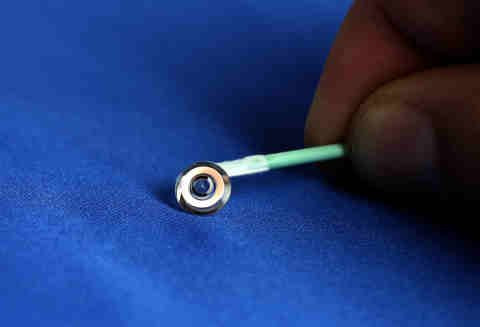Telescopic Contact Lenses And Wink-Controlled Glasses Bring Hope For Visually Impaired

At the recent AAAS Annual Meeting in San Jose, California, optics expert Eric Tremblay from Ecole Polytechnique Fédérale de Lausanne (EPFL) in Switzerland presented the latest breakthrough in low vision aids. The new version of telescopic contact lenses and the electronic glasses enable the lens wearer to shift normal sight to magnified vision by 2.8X. These would benefit 285 million people worldwide who have low vision and age-related macular degeneration (AMD).
Since the introduction of the DARPA telescopic contacts in 2013, scientists have been modifying the prototype and designing accessories to make the eyewear more suited for daily use. A tiny reflecting telescope is attached to the 1.55mm thick lens to expand the wearer’s apparent view. Unlike soft lenses, telescopic contacts are inelastic and larger in diameter like scleral lenses which are generally prescribed for special cases of eye disorders. Tremblay said that although the lens are larger and rigid, they have been constantly modified for safe and convenient use.
Materials used for the new lenses are biologically safe and components are assembled with precision. Air channels were also incorporated to ensure oxygen supply and circulation beneath and around the lens. For the past two years, the scientists have been faced with challenges on enhancing image quality and air permeability. Efforts paid off as improvements in processing the eyewear were achieved in engineering the latest prototypes.
The smart glasses complement the function of the magnifying lenses and automatically adjust the wearer’s view with the wink of an eye. To magnify vision, the wearer just needs to wink the right eye, and to reset to normal view, they left eye is winked. There are commercially available telescopic glasses for AMD, but the combination of the new compact eyewear would be more convenient to use. These could also follow eye movements instantly and would not require adjusting eye and head positions for the wearer to use the eyewear efficiently.
This DARPA-funded project is still in the research stage, but the scientists are hopeful that this technology would be available soon. It is in collaboration with Joe Ford of the University of California in San Diego, Innovega, Paragon Vision Sciences, Pacific Sciences and Engineering and Rockwell Collins.
To send feedback about the content, email: j.panganiban@ibtimes.com.au




















